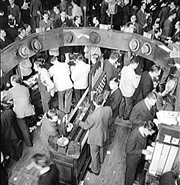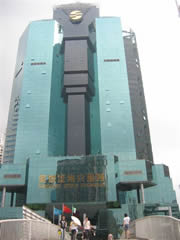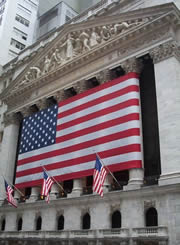The Great American Private-Equity-Buyback Arbitrage Play
by John Schroy filed under Equities, Corporate Managers, Bankers, Brokers, Equity Risk
The US equity market may now be moving into a new phase dominated by massive arbitrage between the value of equities with and without stock buybacks.
As described in the article “US Equities: Wildly Over-Priced or a Great Bargain?“, the half-trillion dollar annual buyback craze that rules American equities has caused a gap to open between the value of equities held for the long-term and value to short-term speculators and those living off unrealized capital gains (like managers of open-end mutual funds).
The reason for this divergence in value is simply that cash paid out for buybacks does not go to long-term stockholders, but instead to corporate executives and short-term speculators.
As shown in the Price-PATAB chart in the article, stocks for the long-term have half of the value they would have if buybacks were paid fairly in the form of dividends.
Private Equity Steps into the Arena!
To take advantage of this divergence of values, vast amounts of money are being borrowed to take companies private. Once a company is private, control is transferred from hired-executives and fund managers into the hands of permanent shareholders. Corporate cash that was being diverted into buybacks can now go directly to shareholders, rather than executives via stock options or to short-term speculators.
Free from ineffective meddling by the SEC and the annoyances of Sarbanes-Oxley, private shareholders can now take control of corporate cash that was being channeled into buybacks, using what was to be buyback money to pay off loans that made the private-equity play possible — in essence, using the company’s own funds to take the company off the market.
Using corporate cash to acquire control, of course, is nothing new. What is different in the private equity movement is that cash dividends have fallen out of favor (See: “Harvard’s Breakthrough Idea: Don’t Pay Dividends!“), and buybacks now dominate the equity market (See: “Corporate Buybacks Continue at Record Levels: Q2 2006“), making it easy to find targets for private-equity-buyback arbitrage.
Private-equity plays are also different in that it is not really necessary to “clean up” a company, undertaking risky reform or restructuring, before putting it into the market again. The key is simply to divert buyback money to pay for ownership and then sell for a profit — essentially a form of slow motion arbitrage.
Of course, the booming trade deficit helps and is essential — money pouring in from abroad keeps interest rates low in the bond market and makes private-equity deals feasible. (See: “Hugo Chavez: The US Bond Market’s Friend“).
Will Private Equity Kill the Buyback Movement?
There is no reasonable doubt that most stock buybacks are unethical and fraudulent (See:”Stock Buybacks, Dividend Equivalency, and Securities Fraud“) and that these buybacks have been the driving force in the US equity market since the mid-1980s.
The question, however, is what will it take to bring the buyback movement to an end? Over the last few years, in this blog we’ve considered various possibilities:
Companies might run out of cash: Up until the market crash of 2000, it seemed that the buyback movement might end when companies no longer could generate the increasing amounts of money needed to continue to force prices upwards with buybacks. However, good economic times stemming from the Bush tax cuts, plus surprising corporate willingness to raid depreciation reserves and borrow to keep buybacks going, have driven buybacks to levels that seemed unimaginable in the pre-2000 years.
The government might step in: There was never much chance that the SEC or Congress would do anything meaningful to protect long-term shareholders from the plundering of buyback pirates, unless there was a major market crash, on the order of 1929 — an even then, probably not.
Lawyers and the courts might take action: Because buybacks are likely to shelter criminal activity, especially stock fraud, there is always the faint chance that the creaky US justice system might start to work against corporate executives and stock buybacks, sending a chill that will discourage the practice. (See:”Buybacks + Options + Hedge Funds + Inside Information = Crime?“)
Public opinion might turn: In the last two years, there has been growing criticism against buybacks, something almost unheard of prior to the crash of 2000. However, the Wall Street propaganda machine and the outright purchase of Congressmen and women, means that any progress along these lines would be a long hard slog. (See: “Investor Alert! Sarbanes Oxley Will Likely Be Gutted in 2007“)
Company executives might suddenly get an attack of morality: There was never much chance of this — not as long as the Harvard Business School continues to sponsor ethical ambiguity. (See: “Jeff Skilling Tells the Truth about US Corporate Ethics“).
Pressure from foreign new issues on the US equity market: Prior to 2000, this was an important consideration and, in fact, it was a major factor in the crash of 2000. However, Sarbannes-Oxley plus the growth of international markets has served to curb non-US corporate enthusiasm for issuing equities in the US.
The private-equity-buyback arbitrage play is an entirely new threat to the buyback movement, with greedy motives and massive funding giving reason to believe that this may, indeed, be the beginning of the end for buybacks.
Greed vs. Greed: A Winning Combination for Ordinary Investors
As long as executives try to use excess corporate cash and buybacks to push up their stock prices and give value to their options, they will be juicy targets for private-equity-buyback arbitrage.
Old line Wall Street firms, like Goldman Sachs, can not be happy with this new development, because any reduction in buybacks cuts off a valuable stream of income from SEC Rule 10b-18 and diminishes their profits — but, don’t worry, they will adapt. Moveover, relative newcomers, like the Blackstone Group are set up to feed off private-equity-buyback arbitrage and are raring to move into center stage. Just as Donaldson, Luftkin, Jenrette shook up the institutional investment market in the 1960s, the private-equity movement signals a major change in the market of the early 21st century.
Meanwhile, what will hired corporate executives be doing, once they wise up to the threat that private-equity-buyback arbitrage represents to their personal financial interests? From their point of view, a take-over is a take-over — someone else is going to call the shots and they won’t be able to put that Olympic swimming pool into their corner office after all.
So how should the smart hired corporate executive respond to this threat. Well, the answer is easy: start paying out buybacks in the form of cash dividends, fairly to all shareholders.
This would would raise current yield dramatically, driving up stock prices and eliminating the value discrepancy. It would give value to executive stock options, give cash to long-term shareholders, and reduce the potential for private-equity-buyback arbitrage. Last, but not least, corporate executives — for the first time in a generation — would be able to claim the moral high ground of actually paying dividends and high yields to small shareholders and retirees.
With corporate executives switching to big-dividend mode, for self-protection, and with private-equity gangs roaming the market seeking out unenlightened troglodytes who insist on buybacks and small dividends, the general level of stock prices should rise nicely, thank you — as long as the trade deficit continues to provide funds to finance this gigantic arbitrage play.
So maybe, after all, Gordon Gecko was right: Greed is good. The market will heal itself. Even the small investors might win.
At least until the Democrats manage to lose the War on Terror and New York City vanishes under an atomic blast. (See: “Victory in Iraq is not an Option — for the Democratic Party“)






